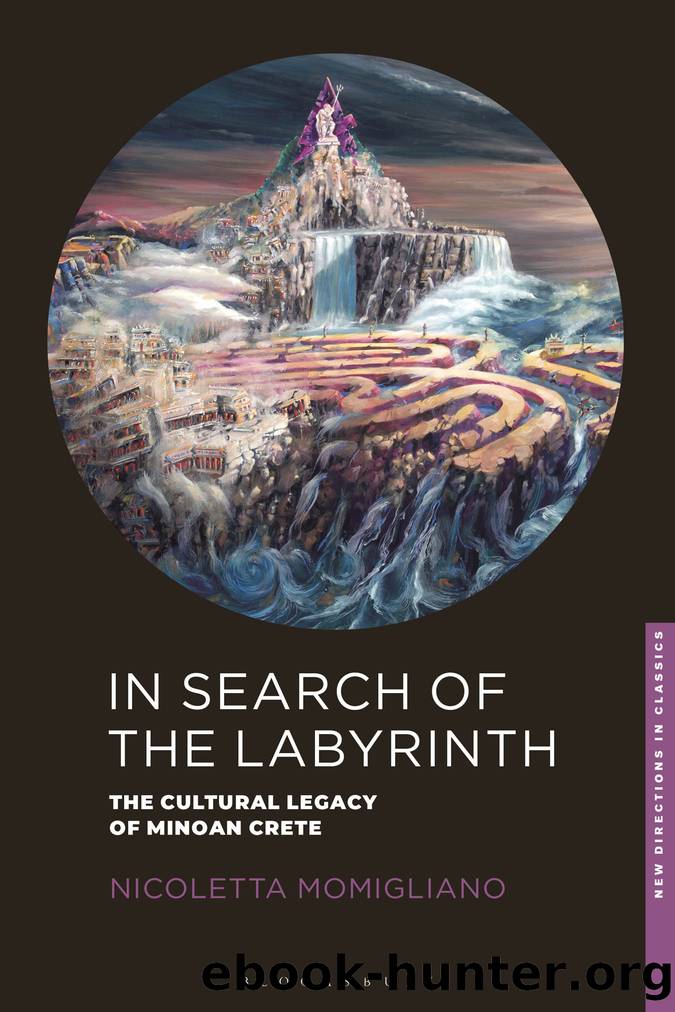In Search of the Labyrinth by Nicoletta Momigliano;

Author:Nicoletta Momigliano; [Momigliano, Nicoletta]
Language: eng
Format: epub
ISBN: 9781350156715
Publisher: Bloomsbury UK
Published: 2020-07-02T00:00:00+00:00
Fig. 5.7 Trading cards with Minoan images created for the Liebig Extract of Meat Company in the 1950s, on display in the Virtual Museum Vallée (http://www.vmv.it/), which includes the Museo della Mucca (Cow Museum): http://www.vmv.it/toro+storia+antica+architettura_1-2-85-3591-4.aspx?ric=0-liebig.
The relationship between the testimony of later Greek sources and the archaeological remains of Bronze Age Crete continued to exercise considerable fascination. Many works, such as those by Spyridon Marinatos in relation to Platoâs myth of Atlantis, Arne Furumark in relation to the Minoan thalassocracy, and Mary Renault in relation to the heroic figure of Theseus, illustrate the persisting conviction that the narratives found in Greek sources contained a kernel of historical truth regarding Aegean Bronze Age events, and could be combined with the archaeology to create a more rational history. But another interesting and different trend also begins to appear, which is connected with the increasing sense of Minoan otherness and distance and emphasizes the disjuncture between Greek narratives and archaeological realities. Examples of this are Bacchelliâs and Lacarrièreâs responses to Knossos, as they describe an incongruity between Greek narratives and the material culture of Minoan Crete, as does Andersonâs fantasy fiction to some extent. This new trend could be seen as a prelude to later interpretations, uses, and appropriation of Minoan Crete discussed in later chapters, which show a greater focus on archaeological remains and more radical reimaginings of ancient Greek mythological stories, or even dispense with them altogether.
Another new trend that emerged in the period discussed in this chapter concerns the idea of Minoan pacifism, which came to be generally perceived as a positive trait, unlike in the interwar period. In fact, the idea of Minoan Crete as a feminine, peaceful society, in which people lived in harmony with nature and with each other, and led very interesting and well-balanced sexual lives, now reached new heights. As anticipated by Henry Miller, and in the words of Lacarrière, Minoan Crete acquired even more âa taste of lost paradiseâ, which was lost not because its people had sinned, but because it was destroyed by external forces and had vanished in the course of time, until archaeologists resurrected it. In the following chapter, however, I shall examine how, in some peopleâs eyes, Minoan Crete did become a paradise lost through the abhorrent transgressions of its inhabitants, and how this paradise was regained.
Download
This site does not store any files on its server. We only index and link to content provided by other sites. Please contact the content providers to delete copyright contents if any and email us, we'll remove relevant links or contents immediately.
| Africa | Americas |
| Arctic & Antarctica | Asia |
| Australia & Oceania | Europe |
| Middle East | Russia |
| United States | World |
| Ancient Civilizations | Military |
| Historical Study & Educational Resources |
The Dawn of Everything by David Graeber & David Wengrow(1564)
The Bomber Mafia by Malcolm Gladwell(1517)
Facing the Mountain by Daniel James Brown(1425)
Submerged Prehistory by Benjamin Jonathan; & Clive Bonsall & Catriona Pickard & Anders Fischer(1375)
Tip Top by Bill James(1291)
Wandering in Strange Lands by Morgan Jerkins(1279)
Evil Geniuses: The Unmaking of America: A Recent History by Kurt Andersen(1269)
Red Roulette : An Insider's Story of Wealth, Power, Corruption, and Vengeance in Today's China (9781982156176) by Shum Desmond(1264)
The Way of Fire and Ice: The Living Tradition of Norse Paganism by Ryan Smith(1254)
Driving While Brown: Sheriff Joe Arpaio Versus the Latino Resistance by Terry Greene Sterling & Jude Joffe-Block(1229)
American Kompromat by Craig Unger(1213)
F*cking History by The Captain(1194)
It Was All a Lie by Stuart Stevens;(1191)
American Dreams by Unknown(1149)
Treasure Islands: Tax Havens and the Men who Stole the World by Nicholas Shaxson(1143)
Evil Geniuses by Kurt Andersen(1142)
White House Inc. by Dan Alexander(1121)
The First Conspiracy by Brad Meltzer & Josh Mensch(1075)
The Fifteen Biggest Lies about the Economy: And Everything Else the Right Doesn't Want You to Know about Taxes, Jobs, and Corporate America by Joshua Holland(1027)
